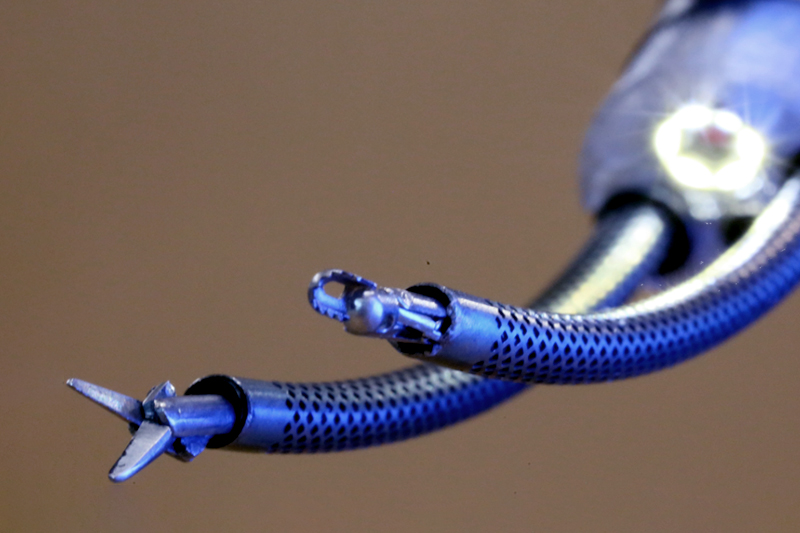This two-handed robot goes deep into the brain

Robots have become common partners in the OR, enabling surgeons to operate through small incisions and manipulate tools endoscopically, avoiding invasive open surgery. But in neurosurgery, robots’ capabilities have been more limited. While they can assist with relatively simple procedures like inserting an electrode, more invasive and complex operations like removing a tumor still require surgeons to open up the skull and brain.
That’s where a prototype two-armed, joystick-controlled neurosurgical robot developed at Boston Children’s Hospital could come in.
Engineer Pierre Dupont, PhD, chief of Pediatric Cardiac Bioengineering at Boston Children’s, developed the robot in consultation with neurosurgeon Scellig Stone, MD, PhD, and others. As described in Science Robotics, the robot ably performed a series of two-handed neurosurgical tasks involved in tumor resection and tumor debulking in lab-created models. Tasks included:
- pulling back the capsule surrounding a model tumor with one arm and holding it in place while cauterizing a blood vessel with the other arm
- pulling the capsule membrane taut with one arm while cutting it with the other arm
- retracting tissue to open a clear line of visualization while aspirating a tumor
- holding the tumor capsule open with one arm while using the second arm to remove pieces of the tumor and feed them into a nearby suction tube (see video).
Both neurosurgeons who tested the two-handed robot (Stone and James Drake, MSc, MBBCh, FRCSC, at the Hospital for Sick Children in Toronto) were able to perform these delicate tasks more quickly than they could with manual tools, and without compressing nearby brain tissue.
“This system is able to interact with tissue and handle contingencies, such as bleeding and controlling tumor debris, which puts it in a different category,” says Stone. “Other robotic systems just provide guidance.”
To the center of the brain and back
The pièce de résistance was endoscopic removal of a pineal tumor at the very center of a 3D model brain, created using imaging data from a 4-month-old patient. Overall, the system’s capabilities suggest that it could enable removal of larger, vascularized tumors that currently require open surgical techniques.

In addition to removing tumors and cysts, Dupont envisions applications in treating hydrocephalus, as well as transurethral endoscopic procedures to treat bladder tumors and benign prostatic hyperplasia.
Dupont hopes that an established device company would eventually take the two-armed robot to a first-in-human trial. A team of MBA students at Babson College is investigating commercialization of the robot for a class project this fall, talking to neurosurgeons, device companies, and venture capital firms as part of the college’s entrepreneurship program.
“The brain is the last part of the body where tool access and articulation are poor,” says Dupont. “Neurosurgeons who have seen the robot all say, ‘This is what we need.’ We want to devise a business model that will work for hospitals, and then go back and refine the robot to fit the model.”
To inquire about the technology, contact Ulysses Sallum, PhD, in Boston Children’s Technology and Innovation Development Office.
Visit the Dupont Laboratory and the Department of Neurosurgery at Boston Children’s.
Related Posts :
-

Robotics, spinal fusion, and the quest for 100 percent accuracy
In any spinal fusion surgery, accurate screw placement is a top priority, and for good reason. Incorrectly positioned screws are ...
-

Soft stents, hardened in place by UV light, allow a snug, custom fit
Airway stents are often used when the trachea and bronchi need to be buttressed, as in children and adults with ...
-

Could gene therapy relieve post-hemorrhagic hydrocephalus?
Premature infants, especially very low birthweight babies, are at risk for intraventricular hemorrhage. A frequent complication of these brain bleeds ...
-

Rethinking cerebral arachnoid cysts through genomics
Cerebral arachnoid cysts are the most common mass-occupying brain lesion in humans. Some cause no noticeable symptoms and may just ...





